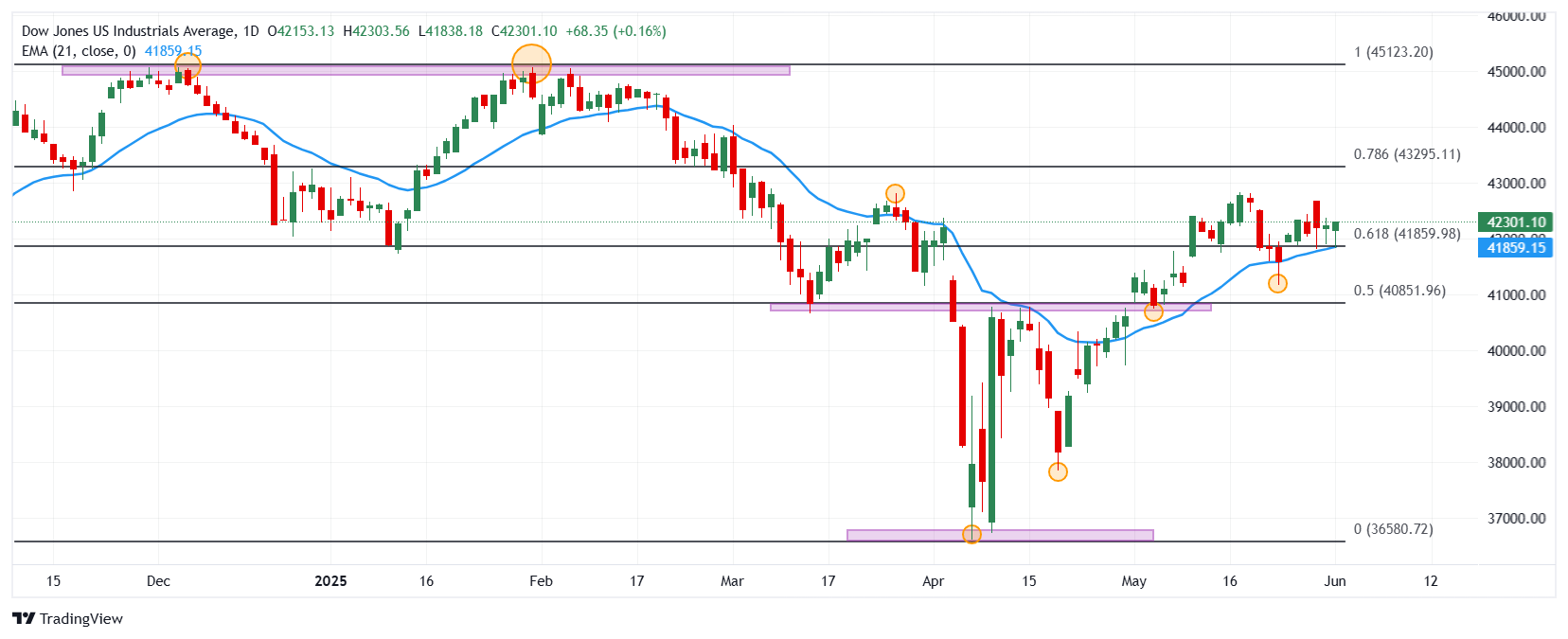- The Dow Jones wins 0.14% today, quoting at the time of writing at 42,301.
- The Nasdaq 100 advances 0.77% daily, driven by Zscaler, Inc. (ZS).
- The S&P 500 rebounded 0.37% on the first day of the week, led by Steel Dynamics. INC (STLD).
- The president of the Chicago Fed, Austan Golsbee, said that the Central Bank will eventually lower short -term interest rates. Once the tariff uncertainty is cleared.
- Donald Trump announced the imposition of 50% tariffs on aluminum and steel, increasing commercial tensions.
The Dow Jones recorded a daily minimum in 41,838, attracting buyers who took the index to a maximum of the day at 42,303.
The Dow Jones industrial average began operating at 42,153, while the Nasdaq 100 technological index opened at 21,304. The S&P 500 started the day in 5,887, operating in the profit zone in synchrony with the main indexes.
The Boeing Company and International Business Machines keep Dow Jones in positive territory
The Dow Jones index rises 0.14% daily, reaching a maximum of the day at 42,301.
The values of The Boeing Company (BA) rebound 1.82% on Monday, reaching maximums not seen since February 8, 2024 in 212.34 $, leading profits in the stock index.
Following the bullish perspective, the titles of International Business Machines (IBM), they earn 1.80% in the day, reaching May 28 in 263.81, signing its second consecutive day upwards.
The Dow Jones advances 55 points, staying within the range of May 30 at 42,301.
Zscaler and Micron Technology, INC leading the profits in Nasdaq 100
The Nasdaq 100 technological index wins 0.77% in the day, currently quoting at 21,486.
Zscaler’s shares (ZS) shoot 6.33% in the first day of the week, visiting maximums not seen since January 4, 2022 in 293.53 $, spinning two consecutive sessions upwards.
In the same tune, the values of micron technology (MU) earn 3.94% daily, reaching May 29 in 99.24 $. Investors will be attentive to the quarterly report of MU, to be released on June 25, where it is expected to obtain income for 8,83 billion dollars and a gain per share of $ 1,582.
In this context, the Nasdaq 100 advances 164 points, reaching maximums of May 29 in 21,500, thus ending with two consecutive days with losses.
The S&P 500 two -day visit promoted by Steel Dynamics
The Institute of Offer Administration (ISM) announced that the May manufacturing PMI was 48.5 points, below the expected 49.5 and 48.7 previously observed.
On the other hand, Donald Trump announced the imposition of 50% tariffs on steel and aluminum imports. After this news, the shares of Steel Dynamics (STLD) rebound 10.27%, reaching maximums not seen since December 5, 2024 in 142.42 $.
At the same time, Austen Goolsbee, president of the Federal Reserve of Chicago, mentioned in his speech today that Fed will lower short -term interest rates when commercial uncertainty dissipates.
In this sense, the S&P 500 wins 0.48% on Monday reaching May 29 in 5,934, in tune with the main stock market indices.
Technical Analysis of Dow Jones
The Dow Jones established a short -term support given by the minimum of May 23 in 41,175. The following key support is observed in 40,747, minimum of May 6 in convergence with the 50% fibonacci setback. To the north, the key resistance is observed at 45,068, pivot point of January 31, 2025.
Dow Jones daily graphics

Dow Jones Faqs
The Dow Jones Industrial Avenge, one of the oldest stock market indexes in the world, consists of the 30 most negotiated values in the United States. The index is weighted by the price instead of capitalization. It is calculated by adding the prices of the values that compose it and dividing them by a factor, currently 0.152. The index was founded by Charles Dow, also founder of the Wall Street Journal. In recent years it has been criticized for not being sufficiently representative, since it only follows 30 companies, unlike broader rates such as S&P 500.
There are many factors that promote the Dow Jones Industrial Average (DJIA) index. The main one is the added performance of the companies that compose it, revealed in the quarterly reports of business benefits. The American and world macroeconomic data also contribute, since they influence investor confidence. The level of interest rates, set by the Federal Reserve (FED), also influences the DJia, since it affects the cost of credit, on which many companies depend largely. Therefore, inflation can be a determining factor, as well as other parameters that influence the decisions of the Federal Reserve.
Dow’s theory is a method to identify the main trend of the stock market developed by Charles Dow. A key step is to compare the direction of the Dow Jones Industrial Avenge (DJIA) and the Dow Jones Transportation Average (DJTA) and just follow the trends in which both move in the same direction. The volume is a confirmation criterion. The theory uses elements of maximum and minimum analysis. Dow’s theory raises three phases of the trend: accumulation, when intelligent money begins to buy or sell; Public participation, when the general public joins the trend; and distribution, when intelligent money abandons the trend.
There are several ways to operate with the DJ. One of them is to use ETF that allow investors to negotiate the DJ as a single value, instead of having to buy shares of the 30 companies that compose it. An outstanding example is the SPDR Dow Jones Industrial Avenge ETF (day). Future contracts on the DJ allow the specular operators about the future value of the index and the options provide the right, but not the obligation, to buy or sell the index at a predetermined price in the future. Investment funds allow investors to buy a part of a diversified portfolio of DJ values, which provides exposure to global index.
Source: Fx Street
I am Joshua Winder, a senior-level journalist and editor at World Stock Market. I specialize in covering news related to the stock market and economic trends. With more than 8 years of experience in this field, I have become an expert in financial reporting.





